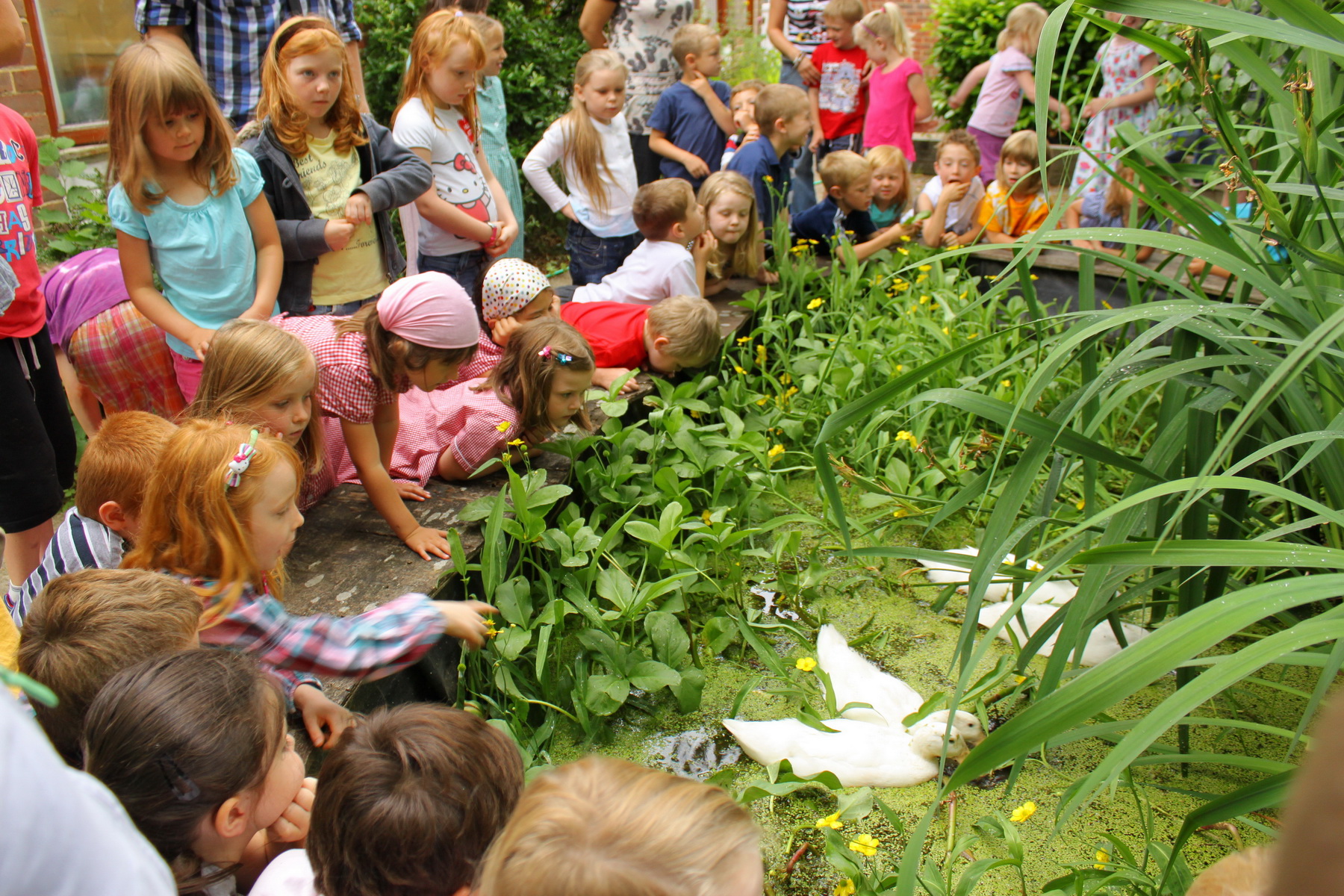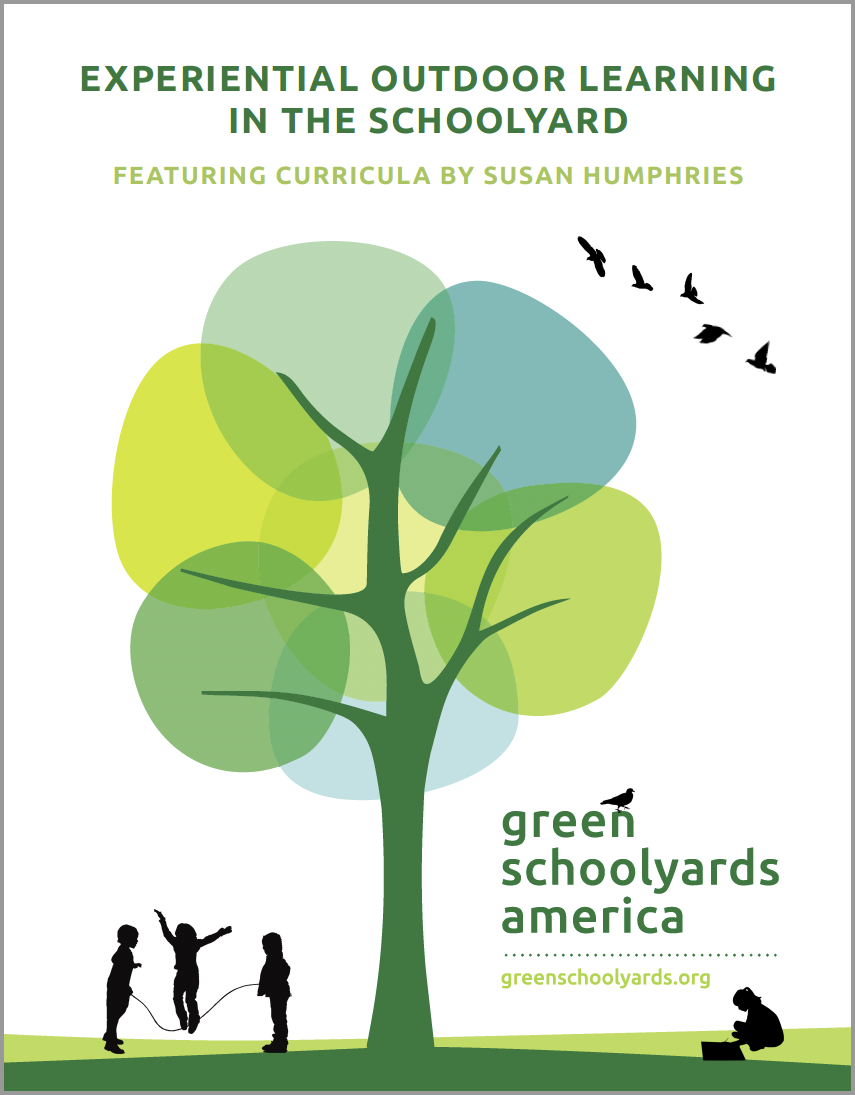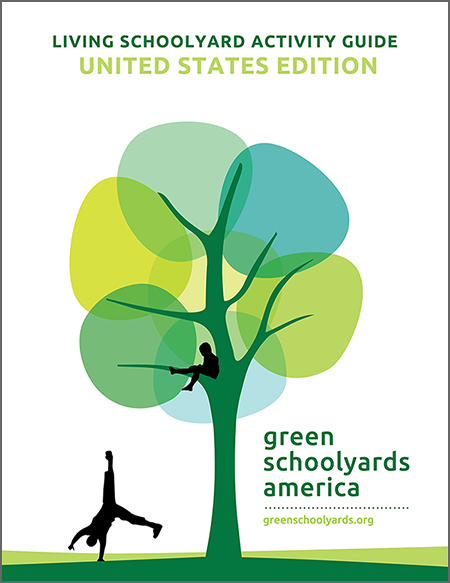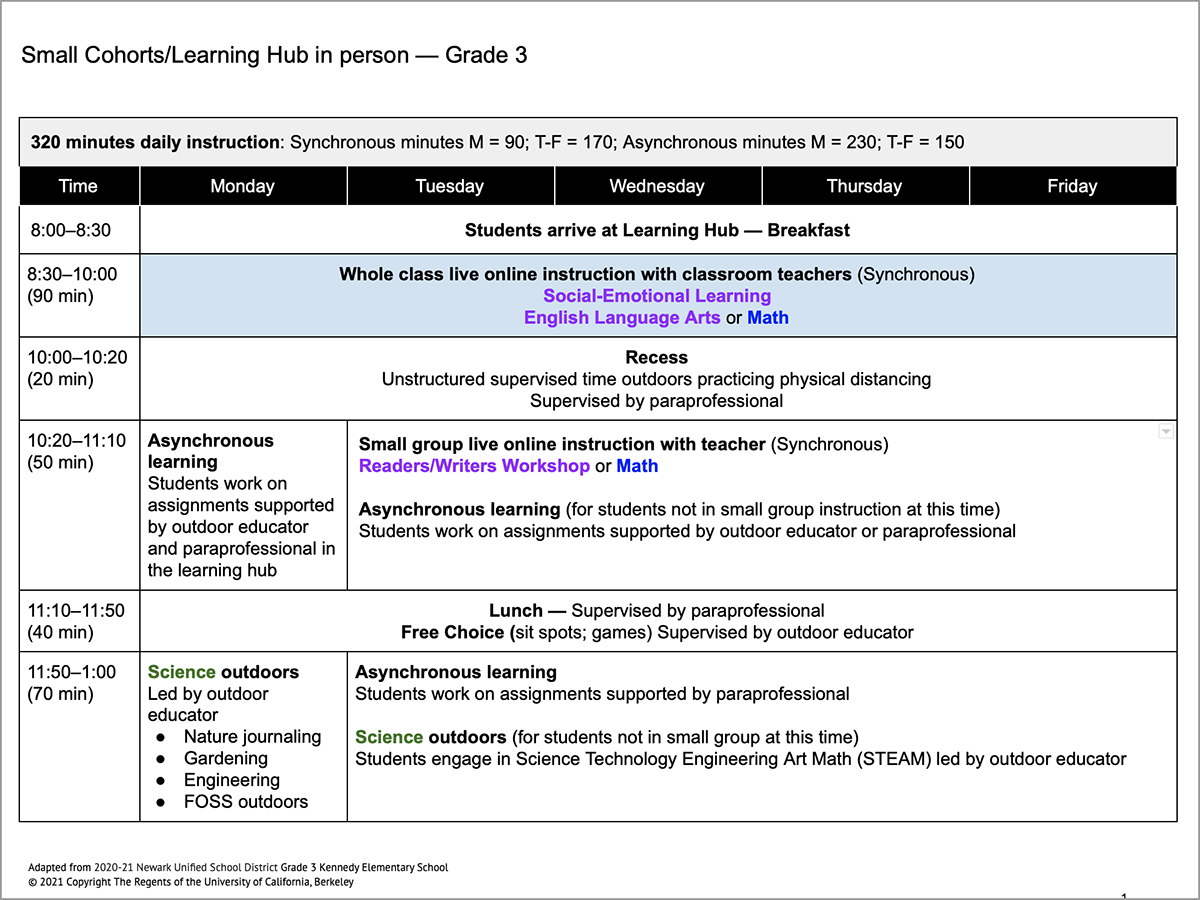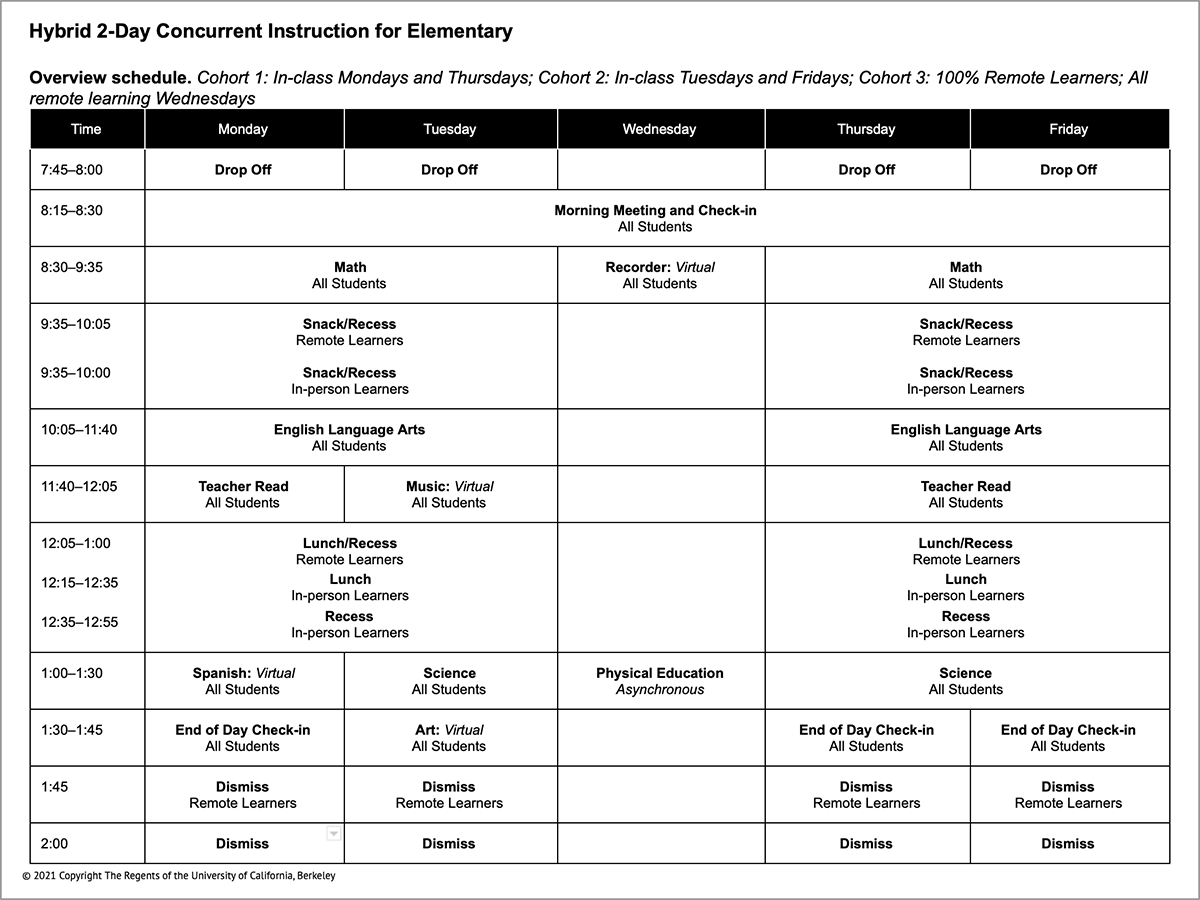Chapter 4
Teaching and Learning Outdoors
Based on the decreased risk of disease transmission in an open-air environment, outdoor areas on school grounds and in local public spaces — such as parks — can be venues for outdoor classrooms and school programming, including physical education, recess, or school meals. In order to bring the school day outside, you will need to plan the staffing and scheduling for the use of these spaces. You will also need to prepare teachers to teach outside, provide curriculum support, and provide guidance on how to manage students in what can be a distracting space. In addition, systems for having meals and conducting recess outside will need to be implemented. In this section, you will find information and resources to support your planning process in taking classes and other programming outside.
The decision to take school outside involves understanding your community’s needs, especially as those needs relate to teaching and learning. Your district may have completed a Racial Equity Impact Assessment or created a framework where decisions are made through the lens of equity. We encourage you to run any new decisions related to outdoor learning and programming through this lens. In addition, returning to in-person instruction after months of distance learning due to the pandemic will require attention to student social-emotional well-being and may need to include space for healing using trauma-informed practices. Outdoor environments can be especially helpful in creating a space for this work.
The resources provided in this section are intended as a starting point to help your community make informed decisions that are right for your own school and district context. Bringing your programming outdoors can help all members of the community stay healthy and engaged.
Land Acknowledgements and Authentic Place-Based Learning
As you begin to engage in outdoor learning, cultivating a sense of place at the center of your approach to curriculum and instruction can be important. As a part of this process, you may choose to include land acknowledgements in your work. Your school district may already have a connection with local Indigenous peoples in your area. For those districts that may not have a formal relationship, consider reaching out to local tribes to cultivate a connection and learn about why land acknowledgements as well as indigenous knowledge could be part of your planning process for ensuring an authentic, place-based outdoor learning program.
GUIDE TO SECTIONS IN CHAPTER 4
Click on the links below to navigate directly to various sections of Chapter 4, or simply scroll down to browse.
Pandemic Planning Strategies (Including Staffing, Scheduling, and Instructional Plans)
Management and Mindset
This section provides resources to support taking instructional time outside. Your teachers will need a strong foundation in outdoor classroom management, and curriculum that is adapted to the space. They will also likely need professional learning to become comfortable in an outdoor classroom and teach engaging content in the space. See the articles below for more.
Outdoor Classroom Management
This article outlines useful strategies and tips for successful teaching and learning in an outdoor classroom.
Tips for Creating a Positive Outdoor Experience for Students
Being outdoors in nature is not always familiar or easy for every student. Creating and maintaining a sense of security should be a priority and this article outlines some helpful tips for doing so.
Taking Curriculum Outside
Fortunately, you don’t have to start from scratch when it comes to planning your scope and sequence outdoors; there are many curriculum resources from which you can draw inspiration or use right away.
An Approach to Walking Field Trips
Wouldn’t it be great if students could build science, literacy and math practices while outdoors? They can! Here is an approach to create school site maps that highlight walkable destinations and routines organized for every grade and for grade spans, K–5.
Science Materials
Opportunities for outdoor learning are many and varied. Transitional kindergarten through grade twelve classroom teachers, environmental educators (e.g., outdoor school field instructors, naturalists, and outdoor interpreters), and expanded learning providers (e.g., after-school programs and summer camps), need materials and tools suited to the learning contexts and the nature of learning opportunities they each provide for students. In this section, we outline three different categories of science instructional materials that can be used across these contexts.
Short Stand-Alone Science Activities
Educators looking for stand-alone and quick (up to one hour) outdoor science activities that are engaging and need little to no preparation will find the following resource helpful.
Extended Science Activity Sequences
Teachers and schools that are looking for an in-depth, multi-day sequence of outdoor learning activities will find the following resources helpful.
Enhancing Adopted Science Curricula for the Outdoors
Teachers and schools looking to go outdoors to enhance an adopted science curriculum will find the following resource helpful.
Professional Learning
Professional Learning for Teachers
There are tried and true methods for providing quality professional learning experiences for your teaching staff that will better prepare them for teaching outside. See this article for guidance.
Professional Learning Program Highlights
The programs highlighted below represent high-quality professional learning that is available to schools and districts looking for support in taking instruction outdoors. In each highlight, we outline each program’s approach and particular area of expertise.
The BEETLES Project — Outdoor Science
The BEETLES Project, at the Lawrence Hall of Science at the University of California, Berkeley, designs research-based professional learning resources for school and program leaders to use with teachers and field instructors.
Life Lab — Garden-based Education
Life Lab offers a variety of professional leaning workshops and resources for schools and districts that want to provide high-quality garden-based learning experiences for their students.
Out Teach — Early Science Experiences
Out Teach works directly with schools and teachers to support their teaching outdoors. Their program is embedded into schools and districts and provides support not only for teaching, but also in creating outdoor teaching spaces.
Enrichment Classes, Programs, and Activities
When schools reopen, outdoor spaces on their grounds and in local parks will be in high demand for many different types of activities and programs. As site planning moves forward at each school, it’s important to consider how all of the different programs and needs can be accommodated outdoors, in an integrated fashion. For example, space may be needed simultaneously or sequentially for physical education, meals, before and after school, and other programming. The Schoolyard Design and Infrastructure page of our website has site planning information and strategies for outdoor classroom spaces. The sections below offer some specific strategies for planning and integrating various activities into your outdoor programming.
Articles on Other School Day Programming
Taking Library Programs Outside
Library programs serve their entire school community, and many library functions can be moved outdoors. Here are a few initial ideas.
Bringing Outdoor Learning Home! — Explore Art in Your Backyard or Neighborhood
You do not need to look far and wide for fun and creative art projects. Here are some simple ideas you can do right in your own backyard or neighborhood and with materials you likely already have.
Explore the Art of Archimboldo in Your Schoolyard
Many paintings of Giuseppe Arcimboldo (1526-1593) were portraits rendered using the forms of vegetables, fruits, and other plants to convey the subject. Learn how to create temporary vegetable portraits inspired by Arcimboldo’s style and process.
Doing Math Outdoors Using Nature Materials
Here are a few ideas to help kids of all ages get outside—in their backyard or local green space—to play with math concepts while they enjoy the natural world.
International School Grounds Month Activity Guide
Learn about how to encourage artistic expression using schoolyards as the backdrop and inspiration. See the chapter in this guide on art, featuring examples fro around the world, on pages 15-33.
Living Schoolyard Activity Guide US Edition
Living school grounds provide settings and inspiration for creative projects ranging from writing to drawing, painting, mosaic, nature art, sculpture, dance, theater, and more. See the chapter in this guide on art, featuring examples from around the country, on pages 23-41.
Music Classes Outside (coming soon!)
Digital Books with Hundreds of Outdoor Activities for School Grounds
Celebrate Your School Grounds! Green Schoolyards America believes school grounds are very important to children and youth, and shape their experience of the world around them. If you agree with us, we hope you will take some time in May during International School Grounds Month and Living Schoolyard Month in California, and year round, to go outside on school grounds with students of any age, to engage in outdoor learning, play and other activities. Click here to read about how to use these wonderful resources.
Experiential Outdoor Learning in the Schoolyard: Featuring Curricula by Susan Humphries (PDF)
This book of 13 hands-on activities was developed following Green Schoolyards America’s September 2019 conference, featuring the work of our esteemed colleague, Susan Humphries. These ideas compliment the other books on this page.
Living Schoolyard Activity Guide: United States Edition (PDF)
This Green Schoolyards America guide now includes 131 ideas for year-round school ground activities, written by 122 organizations from across the United States.
International School Grounds Month Activity Guide
(PDF)
This guide includes an additional 104 ideas for use outdoors in May, written by 73 organizations from 27 countries. It is published by the International School Grounds Alliance (ISGA) and was produced and edited by Green Schoolyards America in collaboration with our ISGA colleagues.
More Resources
Books and Resources for Creating and Managing Outdoor Spaces for Children
Need more information, ideas, and strategies for teaching outside? The outdoor and environmental education, green schoolyard, and school garden fields have decades of experience to share.
District Pathway
If you are a school district just getting started with outdoor learning, this resource is designed to help you launch a district-wide program. It was written with input from district-level outdoor learning experts from across the country.
Start-up Toolkit for Schools
If you are a school looking to get started — this tool will help you visualize and plan for outdoor learning — whether you are looking for low-cost immediate options, using what you already have, or if you are planting seeds for permanent, long-term campus improvements.
PANDEMIC Planning strategies
Planning for Staffing and Scheduling
As schools plan for a return to in-person learning, the ability to physically distance and provide fresh air becomes critical. In order to break classes into smaller groups and reduce the teacher/student ratio, creative staffing and scheduling models are needed. This section of the online library provides resources to help guide your planning process for outdoor teaching and learning.
Planning for Staffing and Scheduling
Schools and districts will need to sort out staffing needs and scheduling as the first step to taking education outdoors. This article outlines the high-level planning considerations.
Staffing Using Community-based Partners
Museums, zoos, aquariums, and environmental or outdoor education nonprofits can be a valuable asset as schools and districts reopen for in person instruction. This article outlines options for using community-based partners to support your outdoor programming.
Guiding Questions for Securing Community-based Partner Staffing Support
Many school systems will find it difficult to expand their staffing capacity without additional support from community-based partners. This article outlines a set of guiding questions for securing support.
Staffing Resources, Case Studies, and vignettes
Sample Community-based Partner MOU
This PDF is a sample MOU created between a school district and a community-based partner that is providing staffing support for learning outside.
Staffing Case Studies
Here we provide several case studies highlighting the use of community-based partners to support staffing needs as schools reopen. (Coming soon!)
Staffing Vignettes
The BEETLES program conducted interviews spotlighting the ways outdoor and environmental education organizations have partnered with schools. Click here for more.
Strategies and Resources for Scheduling
Scheduling Considerations for Outdoor Instruction
Here we review the numerous considerations for creating a schedule that incorporates outdoor learning that works for particular school instructional models.
Changing the Schedule at Your School
Once you have reviewed the considerations for scheduling and the example schedules below, this step by step guide will help you shift the schedule at your school or district.
Outdoor Spaces Scheduling Template
This Google Sheet automates the scheduling of outdoor spaces for use during the school day. Follow this link to view the document, make a copy, and try it yourself.
Schedule Examples
The schedule examples provided here are to help schools and districts plan and organize for outdoor teaching and learning. These resources were created by the Lawrence Hall of Science at the University of California, Berkeley team of Vanessa Lujan, Diana Velez, Sarah Pedemonte, and Craig Strang.
Small In-Person Cohorts for Elementary
This PDF is of a learning hub schedule when school is 100 percent remote learning. It is designed for Kindergarten through sixth grade elementary schools with sample instructional time blocks.
Small In-Person Cohorts for Grade 3
This PDF is of a learning hub schedule when school is 100 percent remote learning. It is designed for third grade with subject matter examples.
Hybrid 2-Day for Emerging Multilingual Learners
This PDF is of a learning hub schedule for a hybrid two-day model only with two cohorts alternating days at the learning hub. It is designed specifically for emerging multilingual learners to include designated English Language Development.
Hybrid 2-Day Concurrent Instruction for Elementary
This PDF is of a hybrid schedule where three cohorts of students are taught concurrently by the classroom teacher. Outdoor spaces at the school site are utilized to support alternating cohorts and groups of students.
Hybrid AM/PM Concurrent Instruction for Secondary Special Day Class
This PDF is of a hybrid schedule where two cohorts of Special Education students are taught by the classroom teacher on a given day. Outdoor spaces are used in alternating AM and PM schedules.
Instructional Plans
Small Cohort Instructional Plans
This tool is intended to support district and school leaders to develop plans for robust, high-quality outdoor teaching and learning that is integrated into small cohort instruction at the school site for their most vulnerable students.
Hybrid Instructional Plans
This tool is intended to support district and school leaders to develop plans for robust, high-quality outdoor teaching and learning that is integrated into any approach to hybrid instruction at the school site.
Full In-person Instructional Plans
The many health and learning benefits of being outdoors make it a desirable feature of an in-person instructional plan. This approach illustrates how educational leaders can build district capacity to integrate equitable, high-quality, outdoor learning experiences into their in-person instructional plans.
Credits
Some of the resources and strategies in this chapter were developed in 2020 by the National COVID-19 Outdoor Learning Initiative’s Working Groups on Teaching and Learning (WG#4/5) and Other Programming (WG#6); and some were developed later in 2021 by a Lawrence Hall of Science team funded by a California Collaborative for Excellence in Education grant and Rachel Pringle of Green Schoolyards America. The Teaching and Learning working group was co-led by Vanessa Carter from San Francisco Unified School District, Rachel Pringle from Green Schoolyards America, and Emily Weiss from the Lawrence Hall of Science. The Other Programming working group was co-led by Sharon Danks of Green Schoolyards America and Amity Sandage of the Santa Cruz County Office of Education. The working groups had many dedicated volunteers from around the country. The Lawrence Hall of Science team was led by Sarah Pedemonte, Vanessa Lujan, and Craig Strang. We would like to express our heartfelt thanks to all of the organizations and individuals who are collaborating to make this Initiative possible.
National Outdoor Learning Library
The National Outdoor Learning Library is an expansive set of resources for schools and districts created by the National COVID-19 Outdoor Learning Initiative, which was founded in 2020 by Green Schoolyards America, The Lawrence Hall of Science, San Mateo County Office of Education, and Ten Strands. With the help of current partners, Green Schoolyards America is continuing to expand the library’s collection to support equitable access to outdoor learning and living schoolyards beyond the pandemic.





















